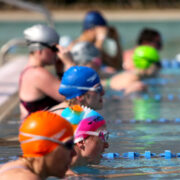7 Simple Truths for a Faster Triathlon Swim
by Coach Troy Jacobson
Most people new to the sport of triathlon find that the swim leg is the most challenging. Images of arms flailing at iconic mass start events bring fear and loathing to many newbies as they struggle with the fundamentals. Putting oneself in the situation of having to navigate through rough waters while in hand to hand combat isn’t appealing to most folks, but the truth is, the triathlon swim is easier than you think and the following list of seven tips will help you get to that finish line faster, and in one piece.
1. Practice consistently and be dedicated to continual improvement.
If there’s one area where most triathletes struggle, it’s with consistency and getting adequate pool time. Triathletes learning the fundamentals of swimming should get into the water at least three days per week, if not four days. Only by putting in the time and energy will you improve and get more comfortable in the water.
2. Focus on the fundamentals of good stroke mechanics.
Swimming, by nature, is unnatural to people. We’re not built to ‘glide’ through the water effortlessly and must work to maximize our efficiency in the water as much as possible. This means focusing on developing proper swim mechanics by breaking down our stroke and practicing drills designed to improve our body position and various components of the freestyle stroke. And this focus never ends… even elite swimmers train and reinforce proper stroke mechanics with a steady diet of drills.
3. Get another set of eyes… use a coach.
As the saying goes, “seeing is believing.” The way you think you look when you swim is often far from how you actually look. Working with a coach who can provide feedback and keep you on track and progressing is important. Frequent video analysis of your stroke will also help you gain a better understanding of what you’re doing correctly and where you can improve.
4. Develop your kick.
Although most triathletes will swim with a buoyant wetsuit on race day, somewhat negating the effectiveness of the kick, the development in training of a strong kick is still essential. Not only will kicking enhance your overall conditioning, it will also help to provide some propulsion, as well as help to stabilize your body position in the water.
5. Join a swim program.
Most areas will have a local masters or triathlon-focused swim program led by a qualified coach. Join the program and use it regularly as the coaching, structured swim training and competition will help drive your performance to the next level.
6. Practice swimming in the open water.
While pool swimming is great for working on the fundamentals of proper stroke mechanics and for conditioning, practicing in open water helps develop specific skills needed on race day. These include sighting, navigating current, swimming in close quarters to other athletes, drafting on fellow competitors and more. And if you intend to wear a wetsuit on race day, be sure to practice with it first in the open water! There’s nothing more uncomfortable than getting to your race, starting the swim and realizing that your wetsuit doesn’t fit properly.
7. Incorporate strength training into your routine.
A stronger athlete is a faster athlete, and get’s injured less often. Adding a strength routine to your swim program in the form of traditional ‘dry land’ modalities using elastic tubing, bodyweight exercises and other tools like medicine balls is a great way to boost your performance.
Incorporate these simple suggestions into your swim program and you’ll be on track to a successful triathlon swim!
Coach Troy Jacobson
Head Coach – Life Time Tri
Troy Jacobson is a former pro, creator of the Spinervals cycling video series and Head Tri-Coach for Life Time. Learn more at www.coachtroy.com.

